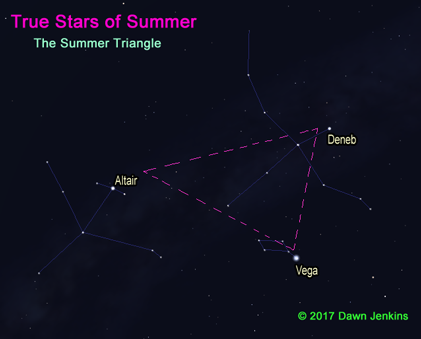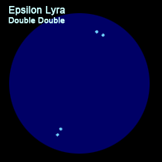
June 2017 - Vol. 21, No. 6
This Month's Night Sky - NOTE: The next paragraph describes the sky as it appears at 10 pm EST (11 pm EDT) near mid- month. The sky also looks this way at 11 pm EST (midnight EDT) during the beginning of the month and at 9 pm EST (10 pm EDT) by month's end.
Spica (Virgo) glows in the SW while Regulus (Leo) vanishes over the W horizon before midnight. The "big dipper" (Ursa Major's asterism) now stands on its "handle" in the N. Antares (Scorpius) is low on the S horizon. The Eastern sky is dominated by the "summer triangle" asterism: Deneb (Cygnus), Vega (Lyra) and Altair (Aquila). An interesting star tour begins at the last star of the big dipper's handle, Alkaid. Following the curve of the handle, "arc to Arcturus". Now, following the same curve, "spike to Spica" and "continue to Corvus", its distinctive four star, kite-shaped, asterism.
MERCURY is in the morning sky this month, reaching aphelion on the 6th, and joining the crescent moon on the 24th. This apparition favors southern-based observers. VENUS shines brightly in the morning sky (mag. -4.7). Our lady of the night is putting on a brilliant show this month so rise early to catch her performance. MARS will be lost in the evening twilight. Take care observing when the red planet is this close to the Sun (16 deg). JUPITER still rules the evening sky. Observers with telescopes may want to observe double transit shadows this month. SATURN reaches opposition on the 15th, the planet will reach mag 0. The rings of the gas giant are wide open for Earth observers so use your telescope to see what details you can resolve with your instrument. URANUS and NEPTUNE also appear in the morning sky to observers armed with telescopes.
Review how to determine Angular Measurement.
Calendar of Events
NOTE: For those observers not in the ET zone, convert the calendar times to your zone's time by subtracting one hour for CT, two for MT and three for PT. Don't forget to adjust for Daylight Savings Time when necessary by subtracting one hour from your planisphere's time. Dawn and dusk times must also be corrected. See your local newspaper, TV news, or cable TV's Weather Channel for sunrise and sunset times or check with the U.S. Naval observatory. Unfortunately some of these events may occur during daylight hours in your area.
| DATE | EVENT |
| 02 | Venus 1.8 deg S. of Uranus. |
| 03 | Venus at greatest elongation W. |
| 04 | Jupiter 2 deg S. of Moon. |
| 08 | Moon at apogee. |
| 10 | Saturn 3 deg S. of Moon. |
| 12 | Venus at aphelion. (Farthest distance in orbit from the Sun.) |
| 15 | Saturn at opposition. |
| 16 | Neptune .7 deg N. of Moon occultation from western Antarctica and south portion of Africa. |
| 20 | Venus 2 deg N. of Moon. |
| 21 | Solstice. Summer arrives in the northern hemisphere and Winter in the south. |
| 22 | Aldebaran 0.5 deg S. of the Moon occultation from most of North America, south Greenland, the Azores, most of Europe, and northwest Africa. |
| 23 | Moon at perigee, expect large tides. |
| 28 | Regulus 0.03 deg N. of the Moon, occultation from Micronesia, Hawaii, Galapagos Islands, Peru, Ecuador. |
Lunar Almanac for June 2017
| Phases of the Moon | Phase and Date(s) | Best viewed before local midnight |
 |
New 24 |
Deep Space Objects |
 |
1st. Qtr 01 |
Planets & Moon |
 |
Full 09 |
Moon |
 |
Last Qtr 17 |
Deep Space & Planets |
Topic of the month: Stars of the Summer Triangle

Summer arrives this month bringing the stars of the "Summer Triangle" and their hosting constellations. The triangle is composed of Vega, Deneb, and Altair (in order of appearance) the alpha stars of their respective constellations. This huge asterism transits the zenith for observers in the northern hemisphere through the months of summer. The three constellations of this triangle have been related to birds throughout the ages and so I like to think of them as the three birds of the Summer Milky Way.
The leading star of the Summer Triangle will be over the horizon by the time the sky becomes dark in the northern hemisphere this month. Alpha Lyrae, more commonly known as Vega, is the fifth brightest star in the sky and the second brightest in the northern hemisphere at mag 0.03. Its home is the constellation of the Lyra, the smallest constellation of the summer triangle. It doesn't look much like a harp or a lyre but the title stuck. The constellation is a small parallelogram. Two other stars in the constellation are quite well known. Closest to Vega is Epsilon Lyra known as the double-double" to backyard astronomers as it resolves readily in small instruments. The four stars appear very close to the same size and brightness and the two doubles appear to be separated by a similar distance, although they appear at right angles to each other. Beta Lyrae is another famous variable star that was enigmatic to astronomers until modern studies revealed that Beta Lyrae is an eclipsing binary. It is a pair of stars in an orbit that is oriented nearly edge-on to our line of sight. One of the stars periodically blocks the other one, causing the combined light of the pair to become dimmer. The primary eclipse occurs when the brighter star is blocked.

Vega became famous in the '80's when the Infrared Astronomical Satellite (IRAS) found evidence of solid material in orbit around it, suggesting that planetary systems might exist around other stars. Vega is a star of firsts. It was the first star to be photographed and the first to have its spectrum recorded. It was once the pole star, 26,000 years ago and due to precession will once again become a cynosure in 12,000 years. Vega is so far north, it may be seen setting and rising on the same night from the northern hemisphere.
Deneb is the brightest star of the constellation Cygnus, the swan, a high flying bird that dominates the night sky and the summer Milky Way. Deneb is a blue giant that is among the 20 brightest stars in the night sky. The name Deneb means tail, so that the bird of Cygnus appears to have a very long neck, because its head is marked by the star, Alberio. Its name once meant something like hen's beak, but erroneous translations and misspellings lead to its official title today. It is a blue and gold double star, I once called it the boy scout star, but varying conditions of the atomosphere and personal color interpretations may give someone else a different impression. In any case, the stars have a remarkable color differential. If you have trouble seeing a bird, you may resonate with Cygnus's other identity, the bright stars of the constellation are called the Northern Cross. If you watch the cross all night from the northern hemisphere, you will notice that it twists in the sky, so that by the time it sets, it appears to hang upright over the western horizon. Deneb, the alpha star of the great swan, appears at the top of the cross on Christmas Day when the constellation appears upright on the western horizon just after sunset.
Alpha Aquilae is Altair the brightest star in Aquila. At mag 0.76, it is one of the closest naked-eye stars, a mere 17 light-years away from our own Sun. Its name means "the flying eagle". It is the southernmost star of the triangle and rises first and sets first. It is flanked by two stars that have been identified by some cultures as a constellation proper, but in accepted modern constellation identification the three stars together is an asterism. Beta Aquilae is called Alshain at mag 3.7, and Gamma Aquilae, is an orange giant called Tarazed (mag 2.7). Together the three stars make up an asterism called the Family of Aquila and they occupy about 5 deg of the sky. All three birds of the summer triangle are birds of prey. One legend that helps us to remember the order of the constellations of the night is that the constellation of the rabbit, known as Lepus, below Orion in the northern sky, will never appear when the birds of prey are flying.
--See You Under the Stars!
Astra for Astra's Almanac
The star chart above was generated by Stellarium, a free open source planetarium program. The above image was created by Dawn Jenkins, using Stellarium and a graphic editing program to format the image for this web page. Editing was done for educational purposes only. Stellarium offers much more to amateur astronomers and is being used in planetariums and to guide telescopes in the field. Simple charts like the one above can be used on the internet for non-profit, illustration purposes. Proper credit is due of course! Thank you to the makers of this fine program from Astra's Star Gate.
This installment of "What's Up?" is ©2017 by Dawn Jenkins for Astra's Stargate. View Ron Leeseburg's Farewell Issue for information on where to find information such as is presented in this almanac.